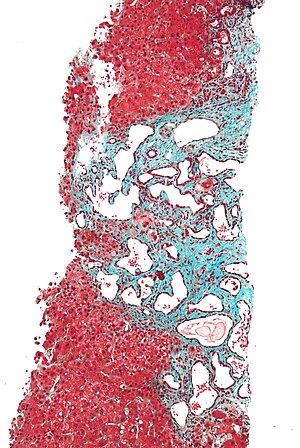Polycystic liver disease
| Polycystic liver disease | |
|---|---|
 | |
Micrograph showing a von Meyenburg complex, a bile duct hamartoma associated with polycystic liver disease. Trichrome stain. | |
| Specialty | Medical genetics |
Polycystic liver disease (PLD) usually describes the presence of multiple cysts scattered throughout normal liver tissue.[1] PLD is commonly seen in association with autosomal-dominant polycystic kidney disease, with a prevalence of 1 in 400 to 1000, and accounts for 8–10% of all cases of end stage renal disease.[2] The much rarer autosomal-dominant polycystic liver disease will progress without any kidney involvement.[2]
Contents
1 Pathophysiology
2 Diagnosis
3 Treatment
4 References
5 Further reading
6 External links
Pathophysiology
Associations with PRKCSH and SEC63 have been described.[3] Polycystic liver disease comes in two forms as autosomal dominant polycystic kidney disease (with kidney cysts) and autosomal dominant polycystic liver disease (liver cysts only).
Diagnosis
Most patients with PLD are asymptomatic with simple cysts found following routine investigations. After confirming the presence of cysts in the liver, laboratory tests may be ordered to check for liver function including bilirubin, alkaline phosphatase, alanine aminotransferase, and prothrombin time.[2]
Patients with PLD often have an enlarged liver which will compress adjacent organs, leading to nausea, respiratory issues, and limited physical ability. Classification of the progression of the disease takes into consideration the amount of remaining liver parenchyma compared to the amount and size of cysts.[2]
Treatment
Many patients are asymptomatic and thus are not candidates for surgery. For patients with pain or complications from the cysts, the goal of treatment is to reduce the size of cysts while protecting the functioning liver parenchyma.[2]
Cysts may be removed surgically or by using aspiration sclerotherapy.[2]
References
^ Kelly, Deirdre A. (2009). Diseases of the Liver and Biliary System in Children. John Wiley & Sons. p. 239. ISBN 9781444300543. Retrieved 7 March 2018..mw-parser-output cite.citation{font-style:inherit}.mw-parser-output .citation q{quotes:"""""""'""'"}.mw-parser-output .citation .cs1-lock-free a{background:url("//upload.wikimedia.org/wikipedia/commons/thumb/6/65/Lock-green.svg/9px-Lock-green.svg.png")no-repeat;background-position:right .1em center}.mw-parser-output .citation .cs1-lock-limited a,.mw-parser-output .citation .cs1-lock-registration a{background:url("//upload.wikimedia.org/wikipedia/commons/thumb/d/d6/Lock-gray-alt-2.svg/9px-Lock-gray-alt-2.svg.png")no-repeat;background-position:right .1em center}.mw-parser-output .citation .cs1-lock-subscription a{background:url("//upload.wikimedia.org/wikipedia/commons/thumb/a/aa/Lock-red-alt-2.svg/9px-Lock-red-alt-2.svg.png")no-repeat;background-position:right .1em center}.mw-parser-output .cs1-subscription,.mw-parser-output .cs1-registration{color:#555}.mw-parser-output .cs1-subscription span,.mw-parser-output .cs1-registration span{border-bottom:1px dotted;cursor:help}.mw-parser-output .cs1-ws-icon a{background:url("//upload.wikimedia.org/wikipedia/commons/thumb/4/4c/Wikisource-logo.svg/12px-Wikisource-logo.svg.png")no-repeat;background-position:right .1em center}.mw-parser-output code.cs1-code{color:inherit;background:inherit;border:inherit;padding:inherit}.mw-parser-output .cs1-hidden-error{display:none;font-size:100%}.mw-parser-output .cs1-visible-error{font-size:100%}.mw-parser-output .cs1-maint{display:none;color:#33aa33;margin-left:0.3em}.mw-parser-output .cs1-subscription,.mw-parser-output .cs1-registration,.mw-parser-output .cs1-format{font-size:95%}.mw-parser-output .cs1-kern-left,.mw-parser-output .cs1-kern-wl-left{padding-left:0.2em}.mw-parser-output .cs1-kern-right,.mw-parser-output .cs1-kern-wl-right{padding-right:0.2em}
^ abcdef Poston, Graeme J.; D’Angelica, Michael; Adam, René (2010). Surgical Management of Hepatobiliary and Pancreatic Disorders, Second Edition. CRC Press. p. 303. ISBN 9781841847603. Retrieved 7 March 2018.
^ Online Mendelian Inheritance in Man (OMIM) 174050
Further reading
Everson, Gregory T. (2008). "Polycystic Liver Disease". Gastroenterology & Hepatology. 4 (3): 179–181. ISSN 1554-7914. PMC 3088294. PMID 21904493.
External links
| Classification | D
|
|---|
- https://web.archive.org/web/20060925144901/http://www.pkdcure.org/site/PageServer?pagename=pkdabt_patientsartic6

Comments
Post a Comment